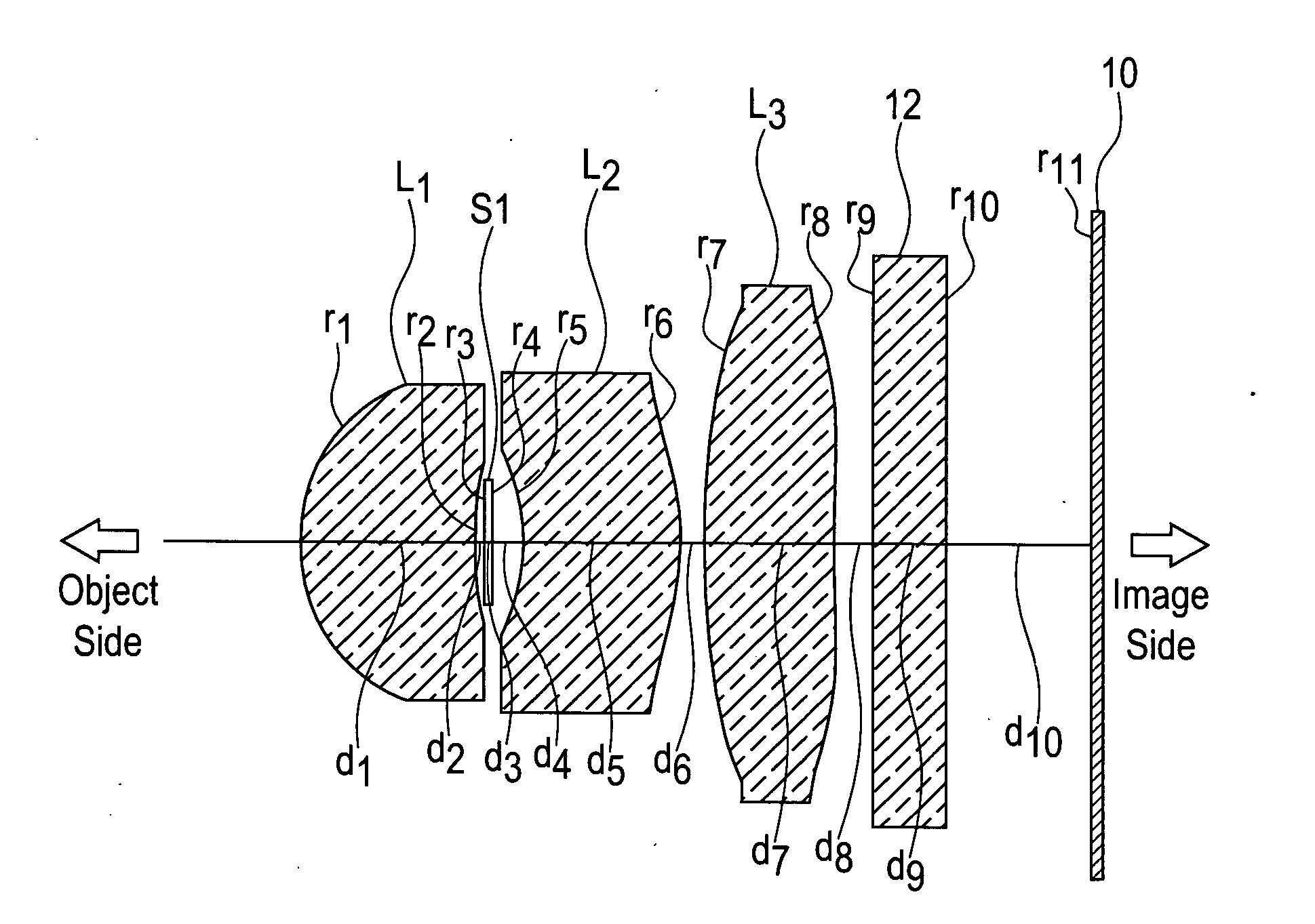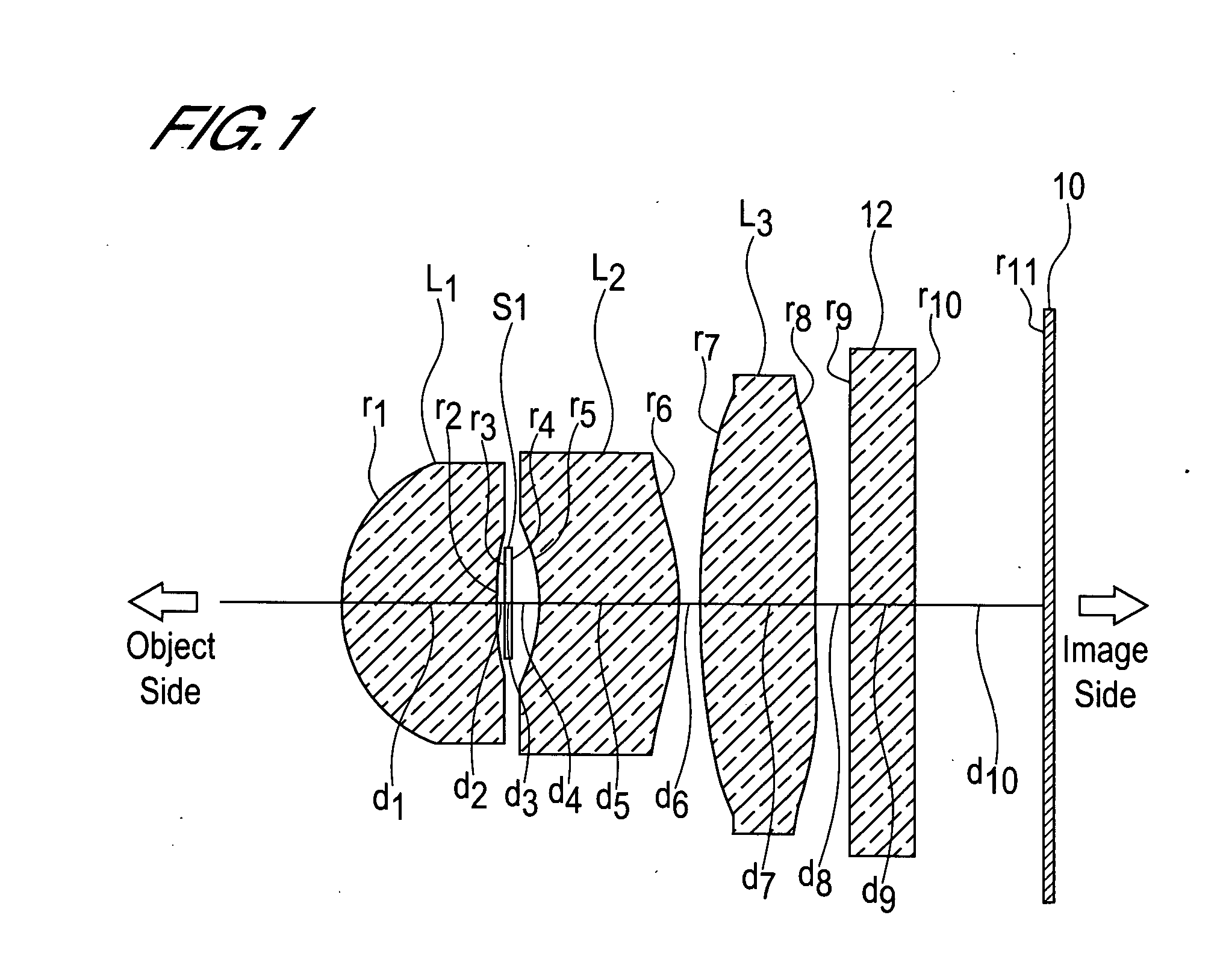Imaging lens
a technology of imaging lens and optical lens, which is applied in the field of imaging lens, can solve the problems of inability to produce compact lenses, inability to reduce the effective diameter of the third lens, and long distance (optical length) from the surface of the first lens on the object side to the imaging surface, etc., and achieves the effect of reducing the abbe number, and reducing the distan
- Summary
- Abstract
- Description
- Claims
- Application Information
AI Technical Summary
Benefits of technology
Problems solved by technology
Method used
Image
Examples
embodiment 1
[0115] (A) The object-side radius of curvature r1 of the first lens L1 is r1=0.296 mm. [0116] (B) The image-side radius of curvature r2 of the first lens L1 is r2=0.720 mm. [0117] (C) The back focus bf is bf=0.365 mm. [0118] (D) The distance through the atmosphere from the object-side surface of the first lens L1 to the imaging surface, or in other words the optical length d, is d=d1+d2+d3+d4+d5+d6+d7+bf=1.195 mm. [0119] (E) The distance D2 between the first lens L1 and second lens L2 is D2=d2+d3+d4=0.076 mm. [0120] (F) The distance D4 between the second lens L2 and third lens L3 is D4=d6=0.0369 mm. [0121] (G) The focal length f1 of the first lens L1 is f1=0.79 mm. [0122] (H) The focal length f2 of the second lens L2 is f2=−5.14 mm. [0123] (I) The focal length f3 of the third lens L3 is f3=10.56 mm.
[0124] Hence [0125] (1) r1 / r2=0.296 / 0.720=0.4111 [0126] (2) D2 / f=0.076 / 1.00=0.076 [0127] (3) D4 / f=0.0369 / 1.00=0.0369 [0128] (4) d / f=1.195 / 1.00=1.195, and [0129] (5) bf / f=0.365 / 1.00=0.365...
embodiment 2
[0139] (A) The object-side radius of curvature r1 of the first lens L1 is r1=0.300 mm. [0140] (B) The image-side radius of curvature r2 of the first lens L1 is r2=0.748 mm. [0141] (C) The back focus bf is bf=0.362 mm. [0142] (D) The distance through the atmosphere from the object-side surface of the first lens L1 to the imaging surface, or in other words the optical length d, is d=d1+d2+d3+d4+d5+d6+d7+bf=1.204 mm. [0143] (E) The distance D2 between the first lens L1 and second lens L2 is D2=d2+d3+d4=0.078 mm. [0144] (F) The distance D4 between the second lens L2 and third lens L3 is D4=d6=0.0232 mm. [0145] (G) The focal length f1 of the first lens L1 is f1=0.79 mm. [0146] (H) The focal length f2 of the second lens L2 is f2=−3.57 mm. [0147] (I) The focal length f3 of the third lens L3 is f3=5.96 mm.
[0148] Hence [0149] (1) r1 / r2=0.300 / 0.748=0.4011 [0150] (2) D2 / f=0.078 / 1.00=0.078 [0151] (3) D4 / f=0.0232 / 1.00=0.0232 [0152] (4) d / f=1.204 / 1.00=1.204, and [0153] (5) bf / f=0.362 / 1.00=0.362....
embodiment 3
[0162] (A) The object-side radius of curvature r1 of the first lens L1 is r1=0.296 mm. [0163] (B) The image-side radius of curvature r2 of the first lens L1 is r2=0.738 mm. [0164] (C) The back focus bf is bf=0.337 mm. [0165] (D) The distance through the atmosphere from the object-side surface of the first lens L1 to the imaging surface, or in other words the optical length d, is d=d1+d2+d3+d4+d5+d6+d7+bf=1.221 mm. [0166] (E) The distance D2 between the first lens L1 and second lens L2 is D2=d2+d3+d4=0.09 mm. [0167] (F) The distance D4 between the second lens L2 and third lens L3 is D4=d6=0.0215 mm. [0168] (G) The focal length f1 of the first lens L1 is f1=0.78 mm. [0169] (H) The focal length f2 of the second lens L2 is f2=−6.27 mm. [0170] (I) The focal length f3 of the third lens L3 is f3=8.56 mm.
[0171] Hence [0172] (1) r1 / r2=0.296 / 0.738=0.4011 [0173] (2) D2 / f=0.09 / 1.00=0.09 [0174] (3) D4 / f=0.0215 / 1.00=0.0215 [0175] (4) d / f=1.221 / 1.00=1.221, and [0176] (5) bf / f=0.337 / 1.00=0.337.
[0...
PUM
 Login to View More
Login to View More Abstract
Description
Claims
Application Information
 Login to View More
Login to View More - R&D
- Intellectual Property
- Life Sciences
- Materials
- Tech Scout
- Unparalleled Data Quality
- Higher Quality Content
- 60% Fewer Hallucinations
Browse by: Latest US Patents, China's latest patents, Technical Efficacy Thesaurus, Application Domain, Technology Topic, Popular Technical Reports.
© 2025 PatSnap. All rights reserved.Legal|Privacy policy|Modern Slavery Act Transparency Statement|Sitemap|About US| Contact US: help@patsnap.com



